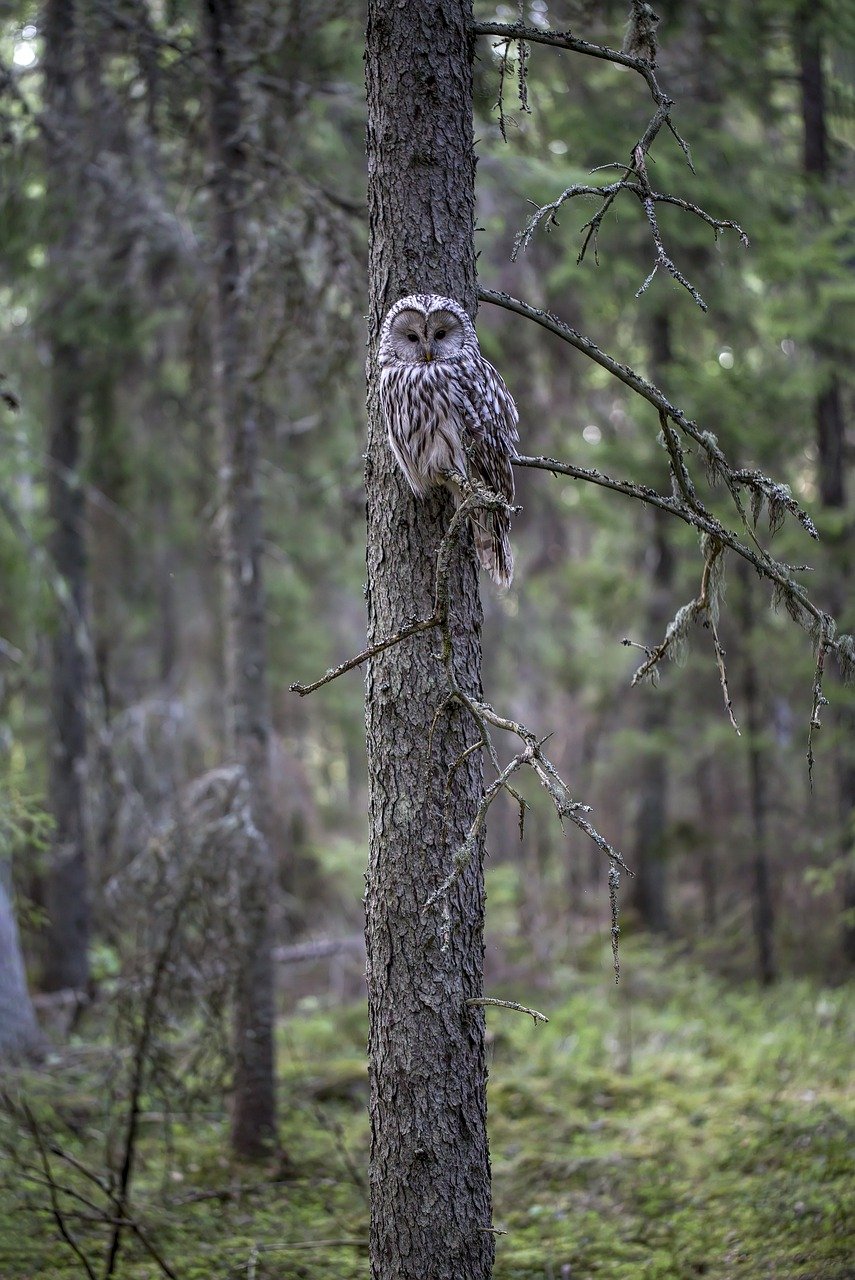Here’s a detailed and comprehensive overview of the Ural Owl (Strix uralensis), a powerful and graceful nocturnal hunter of European and Asian forests:
🦉 Ural Owl (Strix uralensis)
Common Names
- Ural Owl
- European Ural Owl
- Finnish: Viirupöllö
- German: Habichtskauz
- Estonian: Habekakk
Taxonomy & Classification
- Kingdom: Animalia
- Phylum: Chordata
- Class: Aves
- Order: Strigiformes
- Family: Strigidae (True owls)
- Genus: Strix
- Species: S. uralensis
Scientific name meaning:
“Strix” means “owl” in Latin, while “uralensis” refers to the Ural Mountains, one of its main strongholds.
Description & Identification
- Size:
- Length: 50–62 cm
- Wingspan: 110–134 cm
- Weight: 500–1300 g (females larger than males)
- Plumage:
- Overall pale grey to brownish-grey with fine dark streaks.
- Facial disc: Large and round, pale grey-white with darker concentric lines.
- Eyes: Dark brown (unlike the yellow eyes of many other owls).
- Beak: Yellowish.
- Tail: Long and rounded — one of its most distinctive features among European owls.
- Sexual dimorphism: Females are notably larger and heavier than males.
Distribution
- Found across a vast area of Northern Europe and Asia:
- Europe: Scandinavia, Finland, the Baltic States, Poland, Czechia, Austria, the Carpathians, and parts of the Balkans.
- Asia: Ural Mountains, Siberia, Mongolia, northern China, and Japan (Hokkaido).
- Isolated populations occur in the Alps and Central Europe, due to conservation reintroductions.
Habitat
- Prefers mature mixed or coniferous forests with open clearings, meadows, or bogs for hunting.
- Often associated with spruce, pine, and birch forests.
- Requires old trees or large cavities for nesting; may also occupy abandoned raptor or crow nests.
- Avoids dense urban areas but tolerates semi-rural landscapes.
Behavior
- Activity: Mostly nocturnal, though also hunts during twilight and even daylight in northern latitudes.
- Flight: Silent, buoyant, and gliding — typical of large owls.
- Territorial: Pairs maintain territories year-round and can be highly aggressive during nesting season.
- Vocalization:
- Deep, rhythmic hoots, described as “hoo-hoo-hoo-hooo” or “who-who-whoooo”.
- Females have a higher-pitched call; both sexes call in duet during breeding season.
- Longevity: Can live up to 20 years in the wild, occasionally longer in captivity.
Diet & Hunting
- Diet: Carnivorous, primarily feeding on small mammals, especially voles and mice.
- Also preys on:
- Birds (e.g. thrushes, woodpeckers)
- Frogs, insects, and occasionally squirrels.
- Hunting method:
- Perches silently on a branch, using excellent hearing and night vision to detect prey.
- Dives swiftly and silently to seize prey with powerful talons.
Reproduction
- Breeding season: March–May (earlier in southern range).
- Nesting:
- Uses tree cavities, old nests of buzzards, ravens, or black storks, and sometimes nest boxes.
- Lays 2–6 white eggs directly on the substrate, without adding nest material.
- Incubation: About 27–34 days, by the female; male provides food.
- Chicks:
- Hatch covered in white down.
- Fledge after 5–6 weeks but depend on parents for several more weeks.
- Aggression: Adults fiercely defend nests; many researchers report attacks when approaching nests.
Predators & Threats
- Natural predators: Rare — occasionally Eagle Owls (Bubo bubo) or Northern Goshawks (Accipiter gentilis).
- Human-related threats:
- Habitat loss (logging of old forests).
- Vehicle collisions.
- Shooting or disturbance near nesting sites.
- Competitors:
- Tengmalm’s Owl (Aegolius funereus) and Tawny Owl (Strix aluco), which may compete for nest sites.
Conservation Status
- IUCN Red List: 🟢 Least Concern (LC)
- Population trend: Stable or increasing in parts of Europe, declining locally where old-growth forests disappear.
- Protection:
- Protected by national and EU laws (Annex I of the EU Birds Directive).
- Nest boxes and reintroduction projects (e.g., in Austria, Germany, and the Czech Republic) have aided recovery.
Interesting Facts
- The Ural Owl’s range extends from Scandinavia to Japan, making it one of the widest-ranging Strix species.
- It is one of the few owls that may attack humans during breeding season — usually when people come too close to the nest.
- Plays a key role in rodent population control in boreal ecosystems.
- The dark eyes are unique among large European owls (most, like the Tawny or Great Grey Owl, have yellow eyes).
- In Finnish folklore, the Ural Owl was once considered an omen of wisdom or warning.
Visited 822 times, 30 visit(s) today
Views: 1590
Subscribe to the newsletter:
